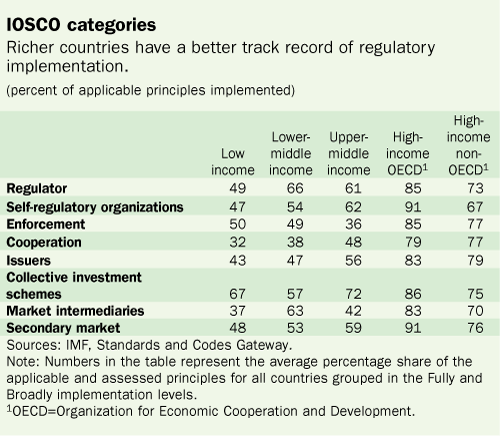
Typical street scene in Santa Ana, El Salvador. (Photo: iStock)
IMF Survey: IMF Study Points to Gaps in Securities Market Regulation
February 4, 2008
- Gaps in securities market regulation are worldwide phenomenon
- A key problem is the lack of skills and resources for effective enforcement
- Strong regulation is vital for market development, financial stability, and growth
The inability of securities market regulators to enforce compliance with existing rules and regulations hinders the healthy development of markets.

Insufficient legal authority, as well as a lack of resources, skills, and political will, has resulted in low enforcement of regulations in some countries (photo: Spencer Platt/Getty).
In many countries, particularly low-income ones, a combination of factors has undermined the capacity of regulators to regulate effectively. These include insufficient legal authority, as well as a lack of resources, skills, and political will. This weak capacity is more acute in areas that are technically complex, such as valuation of assets, risk management practices, and internal controls.
The strength of institutions increases with country income. Thus, while most countries had gaps in regulatory implementation, low-income jurisdictions showed levels of implementation below 50 percent, whereas high-income countries were above 70 percent.
Why regulation?
Securities markets play a critical role in economic growth and financial stability. They serve as a mechanism for transforming savings into financing for the real sector, offering an alternative to bank financing.
Markets provide the best—although imperfect—mechanism for asset pricing. They are also a means for transferring risk and diversifying risk exposure, thus enabling firms to raise capital for new investments. Risk transfer and pricing mechanisms allow financial institutions, such as banks and insurance companies, to manage risk more efficiently. Markets may serve as a cushion against disruption of banking systems, and the more efficient they are, the more they contribute to economic growth.
While the role of securities markets is more evident in industrial countries, these markets are also becoming a source of financing for the larger corporate players in many emerging-market and developing countries. In addition, public and private pension funds and collective investment schemes (mutual funds or unit trust funds) have become more important players in many emerging-market and developing countries and their demand for suitable investments is driving development.
What is being regulated?
Securities market regulation refers to the regulation of public issuers of securities, secondary markets, asset management products, and market intermediaries (brokers, dealers, advisors).
Regulation is intended to address asymmetries of information between issuers and investors, clients and financial intermediaries (such as brokers and dealers), and between counterparties to transactions. It is also meant to ensure the smooth functioning of trading and clearing and settlement mechanisms to prevent market disruption and foster investor confidence.
Securities market regulation has three core objectives:
• to protect investors,
• to ensure that markets are fair, efficient, and transparent, and
• to reduce systemic risk.
To guide countries in meeting these objectives, the International Organization of Securities Commissions (IOSCO) identified and published 30 principles of securities regulation in 1998. The principles are grouped under the following eight categories:
1. Regulators. Regulators should be suitably empowered, independent, and accountable
2. Self regulation. Self-regulatory organizations (SROs)—such as exchanges, trade associations, and private agencies—should observe standards of fairness and confidentiality and be overseen by regulators.
3. Enforcement of regulation. Regulators should have comprehensive inspection, investigation, surveillance, and enforcement powers.
4. Cooperation in regulation. Regulators should be able to share both public and nonpublic information with domestic and foreign counterparts.
5. Issuers. Issuers should provide full, timely, and accurate disclosure of financial results and other information to investors and observe high accounting and auditing standards.
6. Collective investment schemes (CIS). Regulators should set standards for these increasingly popular schemes--notably their legal form and structure, disclosure, and asset valuation practices.
7. Market intermediaries. Regulators should set minimum entry standards as well as capital and other prudential requirements for intermediaries and establish procedures for dealing with their failure.
8. Secondary market. Trading systems and securities exchanges require effective regulation and oversight, and trading activities should be transparent.
What are the main deficiencies?
In 2003, IOSCO developed a methodology and a rating system to assess the degree of compliance with the 30 principles—fully implemented, broadly implemented, partly implemented, and not implemented.
In studying the IOSCO assessments in 74 countries completed between 1999 and September 2007, our study for the IMF identified four main areas of concern: weak supervisory practices, including inspections; weak enforcement; poor valuation rules for investment funds; and a lack of understanding and oversight by regulators of risk management and internal controls of market intermediaries.
Enforcement of compliance with rules and regulations was the overriding weakness in regulatory systems, mainly because of a chronic lack of skilled personnel to conduct inspections and use reporting tools, and a lack of resources, skills, and authority to undertake investigations and bring enforcement actions. Weaknesses in enforcement may also be related to another key weakness: the insufficient independence of regulators.
In addition, many countries pay insufficient attention to reviewing valuation practices—especially in markets where funds have significant holdings in relatively illiquid securities and should not rely entirely on the price assigned by an organized market or exchange. And because many regulators lack the staff skills to fully understand the risks associated with the activities of market participants, they cannot effectively set standards for risk management and internal control, nor effectively evaluate firms' practices.
These findings are reflected in the statistics, which showed that for the majority of the countries, full implementation of the IOSCO principles remain a challenge.
In the study, we found that only four principles—1, 4, 5, and 21, which relate mainly to the regulator and to setting minimum entry standards for market intermediaries—show levels of full implementation equal to or above 80 percent. Moreover, for four principles —2, 3, 10, and 24, which relate to the main findings explained above—the levels of implementation fall below 50 percent.
We also found a high correlation between income levels in a country and the level of implementation of IOSCO principles. Regions show significant differences in implementation: Europe and Asia showed the highest levels of implementation, the Western Hemisphere ranked in the middle, and the Middle East and Central Asia, and Africa showed the weakest implementation.

This article is based on IMF Working Paper 07/259, "Strengths and Weaknesses in Securities Market Regulation: A Global Analysis," by Ana Carvajal and Jennifer Elliott


